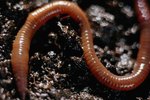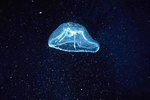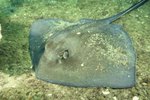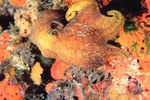
Octopuses are carnivorous marine invertebrates -- animals without a backbone -- of the class Cephalopoda. They are considered the most intelligent invertebrates. Best known for their eight limbs, octopuses possess a diverse arsenal of tactics meant to outsmart and flee from predators. They are found in every ocean and rarely live longer than five years. The smallest species measure only a few inches, while the largest, the giant Pacific octopus, can be 14 feet long.
Camouflage
Octopuses and other cephalopods boast the remarkable ability to instantly change the color and texture of their skin to match their surroundings, be it rocks, sand or coral, and thereby avoid being seen by would-be predators. They owe this capability to thousands of pigment sacs called chromatophores, as well as iridophores, which are cells with reflective properties that mirror the environment. Chromatophores contain five pigments -- brown, black, red, orange and yellow -- that are concentrated in a single point that appears white. Muscles around the chromatophores relax and contract to create different colors and shadings. Raised points in the skin, known as papillae, allow octopuses to change their texture.
Inking
When pursued by a predator, an octopus will give itself an opportunity to escape by releasing a dark pigment along a jet stream of water. The dark cloud that results momentarily conceals the octopus. Moreover, the "ink" contains a chemical called tyrosinase that temporarily inhibits the predator's sense of smell, making it less likely that the octopus will be detected once the dark cloud has dissipated. Octopuses are also known to release ink when attempting to subdue prey. The pigment is stored in a special organ called an ink sac.
Jet Propulsion
A few octopuses walk on the ocean floor, while some deepwater species use fins to swim. In an emergency, however, octopuses can move at rapid speeds through a method of locomotion known as jet propulsion. They accomplish this by sucking water into the mantle, the bulb-like part of the octopus's body that contains its organs. The water is then forced out through a funnel, propelling the octopus in the opposite direction. Once in motion, octopuses can change direction quickly.
Other Adaptations
Because they lack skeletons, octopuses can hide by squeezing into tiny crevices on the ocean floor. They can also sacrifice a limb in order to free themselves from a predator. In some cases, the limb will regenerate. While all octopuses produce venom used to paralyze prey, only the toxins of one species, the blue ringed octopus of Australia, are potent enough to kill a person.
References
- National Geographic: Common Octopus
- Smithsonian National Zoological Park: Cephalopods
- Smithsonian National Zoological Park: Cephalopods - Color Change and Disguise
- Smithsonian National Zoological Park: Inking by Cephalopods
- PBS: Blue-Ringed Octopus
- Vancouver Aquarium: Octopuses & Squids
- Smithsonian National Zoological Park: Giant Pacific Octopus Fact Sheet
- Smithsonian National Zoological Park: Locomotion in Cephalopods
Photo Credits
-
Comstock/Comstock/Getty Images
Writer Bio
Since beginning her career as a professional journalist in 2007, Nathalie Alonso has covered a myriad of topics, including arts, culture and travel, for newspapers and magazines in New York City. She holds a B.A. in American Studies from Columbia University and lives in Queens with her two cats.




